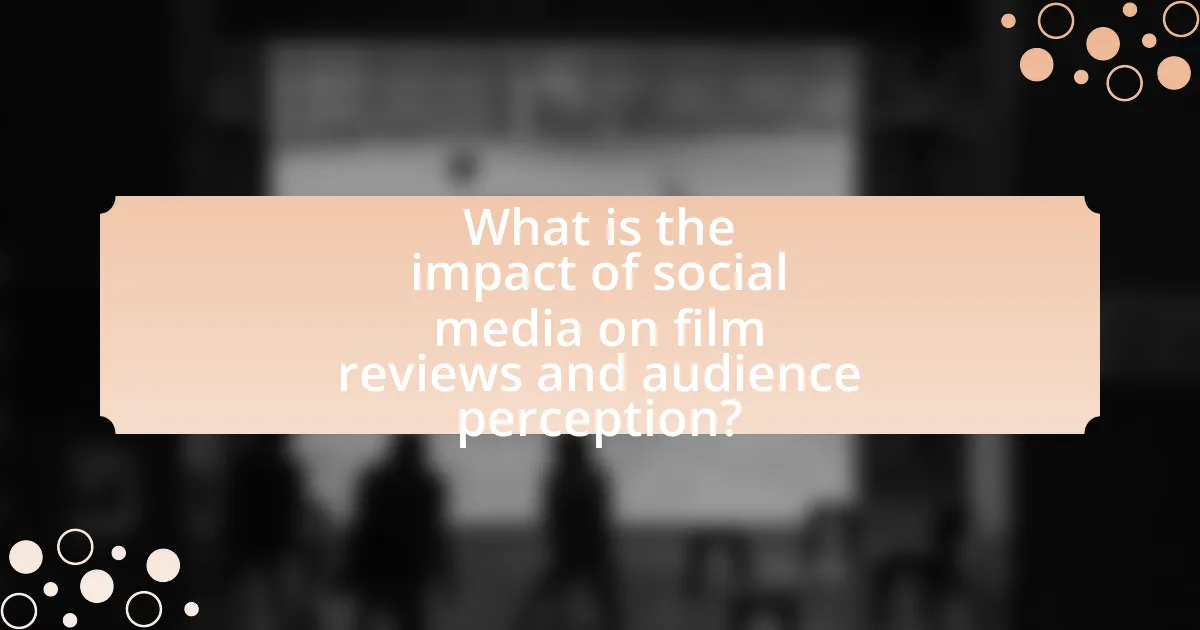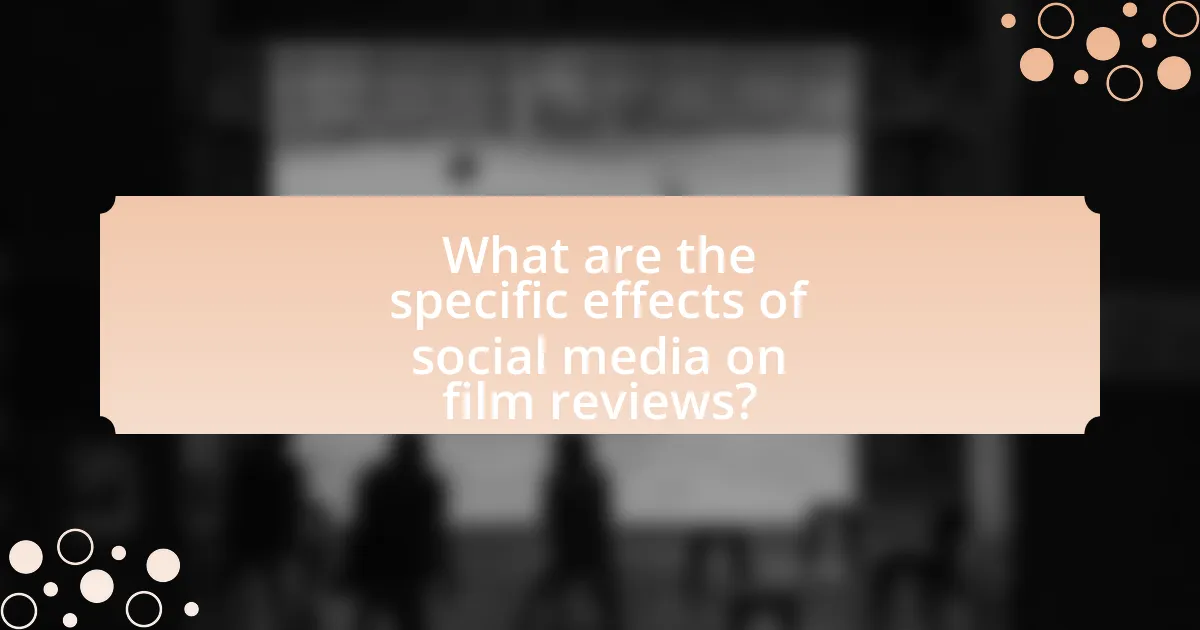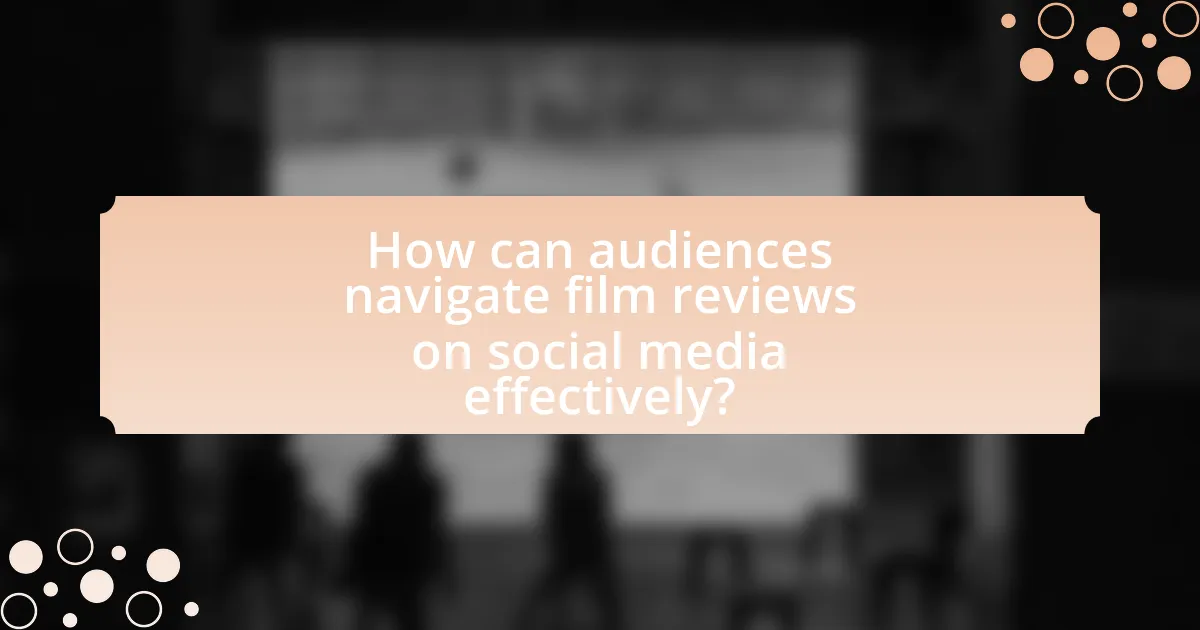The article examines the significant impact of social media on film reviews and audience perception, highlighting how platforms like Twitter and Instagram amplify opinions and facilitate immediate feedback. It discusses the shift in film criticism, where user-generated content often holds more influence than traditional critic reviews, and the role of influencers in shaping public opinion. The article also explores how audience perception affects box office performance, the challenges filmmakers face due to social media, and strategies for audiences to navigate film reviews effectively. Key factors influencing shifts in perception, as well as best practices for constructive engagement in film discussions, are also addressed.

What is the impact of social media on film reviews and audience perception?
Social media significantly influences film reviews and audience perception by amplifying opinions and facilitating immediate feedback. Platforms like Twitter and Instagram allow users to share their thoughts on films instantly, which can shape public opinion and create buzz around a movie. Research indicates that 79% of moviegoers consult social media before deciding to watch a film, highlighting its role in shaping audience choices. Additionally, user-generated content often carries more weight than traditional critic reviews, as audiences tend to trust peer opinions over professional critiques. This shift can lead to films gaining popularity or facing backlash based on social media sentiment, demonstrating the powerful impact of these platforms on the film industry.
How has social media changed the landscape of film criticism?
Social media has transformed film criticism by democratizing the voice of the audience and enabling instant feedback. Traditional film critics, often limited to print or broadcast media, now share their reviews on platforms like Twitter, Instagram, and YouTube, allowing for a broader range of opinions and immediate reactions. This shift has led to the rise of influencers and user-generated content, which can sometimes overshadow established critics. According to a 2021 study by the Pew Research Center, 69% of adults in the U.S. use social media, making it a significant platform for film discussions and reviews. Consequently, filmmakers and studios increasingly consider social media sentiment when marketing films and gauging audience reactions.
What role do influencers play in shaping film reviews on social media?
Influencers significantly shape film reviews on social media by leveraging their large followings to amplify opinions and critiques. Their endorsements or criticisms can sway audience perceptions, as followers often trust influencers’ insights over traditional media sources. For instance, a study by the Pew Research Center found that 72% of teens trust influencers more than celebrities, indicating their substantial impact on shaping public opinion regarding films. Additionally, influencers often create engaging content that highlights specific aspects of films, making their reviews more relatable and accessible, which further influences audience reception and discussion around the films.
How do user-generated reviews compare to traditional critic reviews?
User-generated reviews often reflect a broader range of opinions and experiences compared to traditional critic reviews, which tend to be more structured and professional. Research indicates that user-generated reviews can provide insights into audience preferences and emotional responses, while traditional critics may focus on technical aspects and artistic merit. A study published in the Journal of Consumer Research found that user reviews significantly influence consumer behavior, with 79% of people trusting online reviews as much as personal recommendations. This highlights the growing importance of user-generated content in shaping audience perception and decision-making in the film industry.
Why is audience perception important in the context of film reviews?
Audience perception is crucial in the context of film reviews because it directly influences the film’s reception and box office performance. When audiences share their opinions on social media platforms, these perceptions can shape the expectations of potential viewers, leading to increased interest or aversion. For instance, a study by the University of Southern California found that films with positive audience reviews on social media platforms tend to perform better at the box office, demonstrating the significant impact of audience sentiment on commercial success.
How does audience perception influence box office performance?
Audience perception significantly influences box office performance by shaping viewer expectations and driving ticket sales. Positive audience perception, often amplified through social media, can lead to increased word-of-mouth promotion, resulting in higher attendance rates. For instance, films like “Black Panther” and “Joker” experienced strong box office success, partly due to favorable audience reviews and social media buzz that created anticipation and excitement. Conversely, negative perceptions can deter potential viewers, as seen with films that receive poor audience ratings, leading to lower box office returns. Thus, audience perception acts as a critical factor in determining a film’s financial success.
What factors contribute to shifts in audience perception due to social media?
Shifts in audience perception due to social media are primarily influenced by the speed of information dissemination, the prevalence of user-generated content, and the impact of social validation. Social media platforms enable rapid sharing of opinions and reviews, which can quickly alter public sentiment about films. For instance, a study by the Pew Research Center found that 72% of adults use social media, making it a significant source of information for audiences. Additionally, user-generated content, such as reviews and ratings on platforms like Rotten Tomatoes and IMDb, shapes perceptions by providing diverse viewpoints that can either reinforce or challenge traditional critic reviews. Lastly, social validation through likes, shares, and comments creates a bandwagon effect, where individuals are more likely to adopt popular opinions, further influencing their perception of films.

What are the specific effects of social media on film reviews?
Social media significantly influences film reviews by amplifying audience voices and shaping public perception. Platforms like Twitter and Instagram allow users to share immediate reactions, which can lead to viral trends that impact a film’s box office performance. For instance, a study by the University of Southern California found that films with higher social media engagement often see increased ticket sales, demonstrating a direct correlation between online buzz and audience turnout. Additionally, social media can democratize film criticism, enabling diverse opinions to emerge, which can challenge traditional critic narratives and alter the overall reception of a film.
How do platforms like Twitter and Instagram affect film marketing?
Platforms like Twitter and Instagram significantly enhance film marketing by enabling direct engagement with audiences and facilitating viral content sharing. These platforms allow filmmakers and studios to create targeted promotional campaigns that reach specific demographics, leveraging user-generated content and influencer partnerships to amplify visibility. For instance, a study by the University of Southern California found that films with active social media campaigns can increase box office revenue by up to 20%. Additionally, the visual nature of Instagram allows for compelling imagery and trailers that can capture audience interest quickly, while Twitter’s real-time interaction fosters discussions and buzz around film releases, further driving audience engagement and anticipation.
What strategies do filmmakers use to engage audiences on social media?
Filmmakers engage audiences on social media through targeted content, interactive campaigns, and community building. Targeted content includes behind-the-scenes footage, trailers, and exclusive interviews that create anticipation and excitement around a film. Interactive campaigns often involve polls, contests, and Q&A sessions that encourage audience participation and foster a sense of connection. Community building is achieved by responding to fan comments, sharing user-generated content, and creating dedicated hashtags that allow fans to engage with each other and the filmmakers. These strategies have been shown to increase audience engagement and enhance the overall perception of films, as evidenced by the success of films like “Deadpool,” which utilized social media effectively to build a loyal fan base prior to release.
How do hashtags and trends impact the visibility of film reviews?
Hashtags and trends significantly enhance the visibility of film reviews by increasing their discoverability on social media platforms. When users incorporate relevant hashtags, such as the film’s title or popular trends, their reviews become more searchable, allowing a broader audience to engage with the content. For instance, a study by the Pew Research Center found that 69% of adults in the U.S. use social media, and posts with hashtags receive 12.6% more engagement than those without. This increased engagement leads to higher visibility, as more users are likely to share and comment on reviews that are trending or tagged appropriately.
What challenges do filmmakers face due to social media’s influence?
Filmmakers face significant challenges due to social media’s influence, primarily in managing audience expectations and navigating the rapid dissemination of information. Social media platforms allow for immediate feedback and reviews, which can shape public perception before a film’s official release. For instance, a negative tweet or viral post can lead to decreased box office performance, as seen with films like “Cats,” which suffered from early negative social media reactions. Additionally, filmmakers must contend with the pressure to create content that resonates with social media trends, often prioritizing shareability over artistic integrity. This shift can dilute the storytelling process, as filmmakers may feel compelled to cater to the preferences of online audiences rather than focusing on their creative vision.
How can negative reviews on social media affect a film’s reputation?
Negative reviews on social media can significantly damage a film’s reputation by influencing public perception and reducing audience interest. When users share negative opinions, they can reach a wide audience quickly, leading to a decline in box office sales and overall viewership. For instance, a study by the University of Southern California found that films with a higher volume of negative social media sentiment experienced a 20% decrease in ticket sales compared to those with positive sentiment. This demonstrates that negative reviews can create a ripple effect, where potential viewers are deterred from watching the film based on the opinions of others, ultimately harming its reputation in the industry.
What measures can filmmakers take to mitigate backlash from social media?
Filmmakers can mitigate backlash from social media by actively engaging with their audience and addressing concerns transparently. This involves monitoring social media platforms for feedback and criticism, responding promptly to negative comments, and clarifying any misunderstandings about their work. Research indicates that films with proactive social media strategies, such as open dialogues and addressing controversies, tend to experience less backlash. For instance, the film “Black Panther” successfully navigated potential backlash by emphasizing its cultural significance and engaging with audiences through various platforms, leading to a positive reception despite initial criticisms.

How can audiences navigate film reviews on social media effectively?
Audiences can navigate film reviews on social media effectively by utilizing specific strategies such as filtering content, engaging with credible sources, and analyzing sentiment. Filtering content involves using platform tools to search for reviews from verified critics or reputable publications, which enhances the reliability of the information. Engaging with credible sources, such as established film critics or industry professionals, ensures that audiences receive informed opinions rather than unverified user-generated content. Analyzing sentiment through the aggregation of multiple reviews can provide a balanced perspective, as studies show that diverse viewpoints lead to a more comprehensive understanding of a film’s reception. For instance, a 2021 study published in the Journal of Media Studies found that audiences who considered multiple reviews reported higher satisfaction with their film choices.
What tips can help audiences discern credible film reviews on social media?
To discern credible film reviews on social media, audiences should evaluate the reviewer’s credentials, analyze the review’s content, and consider the engagement level of the post. Reviewers with a background in film criticism or a history of insightful reviews are more likely to provide credible insights. Additionally, credible reviews often include specific examples from the film, such as character development or cinematography, rather than vague opinions. Posts that generate thoughtful discussions or responses from other users can indicate a higher level of credibility, as they reflect a broader engagement with the film’s themes and quality.
How can audiences identify biased or misleading reviews?
Audiences can identify biased or misleading reviews by analyzing the language used, checking for extreme opinions, and evaluating the reviewer’s credibility. Reviews that employ overly emotional language or absolute terms like “always” or “never” often indicate bias. Additionally, if a review presents a one-sided perspective without acknowledging any potential drawbacks, it may be misleading. Research shows that reviews from verified users or those with a history of balanced feedback tend to be more reliable, as they reflect a broader range of experiences.
What resources are available for audiences seeking reliable film critiques?
Audiences seeking reliable film critiques can access several resources, including established film review websites, professional critic publications, and social media platforms. Websites like Rotten Tomatoes and Metacritic aggregate reviews from critics and audiences, providing a comprehensive overview of a film’s reception. Professional publications such as Variety, The Hollywood Reporter, and The Guardian feature critiques from experienced film critics, ensuring high-quality analysis. Additionally, social media platforms like Twitter and Instagram allow audiences to follow critics and engage with real-time discussions, although the reliability of individual opinions may vary. These resources collectively offer a well-rounded perspective on films, aiding audiences in making informed viewing choices.
How can audiences contribute positively to film discussions on social media?
Audiences can contribute positively to film discussions on social media by sharing thoughtful insights and respectful critiques. Engaging in constructive dialogue encourages diverse perspectives and enhances the overall conversation about films. Research indicates that respectful interactions can lead to a more inclusive environment, fostering community among film enthusiasts. For instance, a study published in the Journal of Communication found that positive engagement in online discussions significantly improves the quality of discourse and audience satisfaction.
What best practices should audiences follow when sharing their opinions online?
Audiences should ensure their opinions shared online are respectful, constructive, and fact-based. Respectful communication fosters a positive dialogue and encourages diverse viewpoints, while constructive feedback helps others understand the rationale behind opinions. Fact-based opinions enhance credibility; for instance, citing specific scenes or performances when discussing a film can substantiate claims and provide clarity. According to a study by the Pew Research Center, 64% of social media users believe that respectful discourse is essential for productive online interactions, highlighting the importance of these best practices in shaping audience perception and engagement.
How can constructive feedback enhance the film review landscape?
Constructive feedback can enhance the film review landscape by fostering a more informed and engaged audience. When reviewers provide specific, actionable insights, it encourages filmmakers to improve their craft and helps audiences develop a deeper understanding of cinematic elements. For instance, studies show that reviews incorporating constructive criticism lead to higher viewer engagement and satisfaction, as audiences feel more connected to the content and its creators. This dynamic creates a feedback loop where filmmakers are motivated to innovate, and audiences are more likely to participate in discussions, ultimately enriching the film review ecosystem.